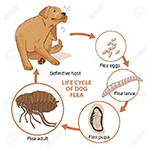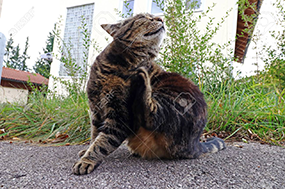Fleas
The cat flea is the most common type of flea. It feeds on dogs and humans also. Cat flea infestations typically begin with pets that have brought fleas indoors and conditions that favor flea development and reproduction. The pests have a much wider range of hosts than most other flea species. This wide range of potential hosts is an important factor since homeowners that do not have pets may have problems with cat fleas that are located on the property or were brought inside the home from an outside source. The cat flea’s lifespan usually lasts from about 1 to 2 1/2 months and really depends on the temperature and humidity of their habitat, especially in East Texas.
A female flea lays 200 to 400 eggs over a period of time. They develop into flea larvae, which look like maggots, within two days to several weeks, depending on the temperature and humidity. Fleas go through a complete metamorphosis. There are four distinct stages: eggs, larvae, pupae, and adult. A special note: A flea can jump 7 to 8 inches vertically and 14 to 16 inches horizontally.
Rats, mice, squirrels or other nuisance pests living in or around the home may also be a source of infestation. Therefore, a problem for homeowners may occur when an infested wild animal occupies a chimney or a crawl space. Excessive amounts of squirrels living in trees around a home can also be a source of fleas. However, the source of a cat flea problem inside the home is very likely a result of a pet being infested while roaming outside the home and then bringing cat fleas inside.

Fleas - The flea life cycle has four stages - egg, larvae, pupae and adult. An Immune Growth Regulator (IGR) prevents the larva from being able to go into the pupal stage, helping to break the life cycle. The pupal stage of the flea life cycle will not be affected by our treatment until they emerge as adults, so you may see adult fleas for up to three weeks. These adults should die shortly after they emerge.
Download the Flea Treatment Plan PDF here
How to prepare before we service your structure:
1. Please make arrangements to have your pet(s) (dog or cat) treated for fleas on the same day as our treatment. No pets should be in structure while it is being treated.
2. Prior to your scheduled service (that day or the evening before), remove all items from the floor such as toys, shoes, papers, boxes, etc. Don't forget closets where shoes and clothes are stored and especially under beds! Also, please lift all bed-skirts from floors.
3. Vacuum rugs and carpets thoroughly! This removes adult fleas and flea eggs as well as preparing the carpet to better accept the aerosol into the base fibers. Dispose of the vacuum bag outside in a sealed plastic garbage bag away from structure.
4. Remove pet dishes
5. Please remove all pet dishes, water hose, toys, etc. from around the outside of your house.
6. For yard treatment, your lawn must be freshly cut and raked or all leaves removed to provide direct contact with soil. 7. After yard treatment, water grass and soil, but not to the point of run-off.
Servicing your home for fleas:
1. The carpeted areas of your home and upholstered furniture will be treated. Any throw pillows on your sofa(s), cushion(s) in chairs, etc. will be turned up if possible and treated. We use an aerosol product that contains two types of active ingredients. One of these will kill the adult fleas and the other ingredient is an insect growth regulator (IGR).
2. We will also do a perimeter/spot treatment in critical areas outside your home.
When your home has received a Flea Treatment:
1. You need to stay out of the house for at least 4-6 hours after service.
2. Vacuum daily for at least 21 days consecutively after the treatment
3. Do not clean carpets until fleas have been gone for several weeks. (We recommend that any carpet cleaning be done prior to service.)
4. Be patient. You may continue to see adult fleas for up to 3 weeks. You should continue to vacuum, sweep and mop vinyl, tile, etc. If you are still seeing fleas after 4 weeks, call our office.
For your flea treatment to be successful it is extremely important that you follow these guidelines.



